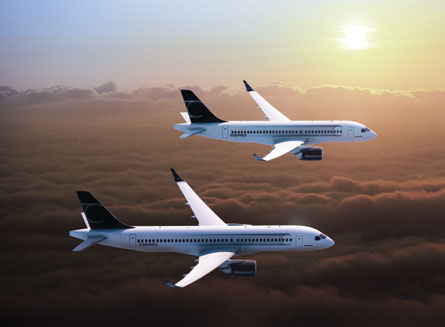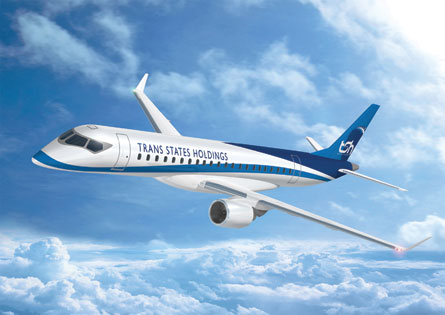Regional aircraft manufacturers and their suppliers can expect a steady stream of new orders over the next 10 years - but a repeat of the last decade's regional jet boom is unlikely.
Airline interest is likely to centre on large aircraft with 90 seats or more, particularly if there is relaxation or elimination of scope clauses - pilot contract riders that place an artificial cap on seating capacity for regional partners.
According to the most recent study from Forecast International (FI), 4,016 regional aircraft worth $123 billion will be produced between 2010 and 2019, with nearly 65% falling into the 76- to 130-seat category. The next largest slice of the regional demand pie, around 33%, is aircraft in the 51- to 75-seat range. Smaller aircraft comprise less than 3%.
"We've seen a rebound in order activity at Boeing and Airbus since the air traffic has come back, but this has not occurred at the regional level," says Ray Jaworowski, a senior aerospace analyst with Connecticut-based FI. "In past airline downturns, the regional sector did fairly well as the majors were hurting - they were able to pick up routes as the majors abandoned them. That didn't happen this time around. The majors killed some routes altogether, forcing capacity constraints down the line."
 |
|---|
©BombardierRepublic's CSeries order: Neo trigger? |
Never have the majors been in a better position to extract concessions from their regional partners. In some cases, the traditional fee-for-departure agreements that defined the major-regional relationship for decades have been scrapped. Often this has occurred in the wake of major airline mergers or bankruptcies. Mergers are typically bad news for the regionals, as they can lead to the elimination of hub-and-spoke feeder service in the name of network rationalisation.
Higher fuel prices and rising costs have rendered 50-seat regional jets unprofitable. By turboprop-maker ATR's count, around 170 regional jets of 30-50 seats stopped flying in the past few years, and more than 220 routes of less than 550km (300nm) have been slashed since 2004.
"Where demand does not justify a switch to larger aircraft, airlines just cut service," says Filippo Bagnato, ATR's chief executive. "There is a high risk of additional service cuts, as 75% of the regional routes up to 300nm are operated by regional jets."
DEMAND SUPRISINGLY RESILIENT
Although it appears unlikely that ATR will fill these growing service gaps with new, -600 variants of the ATR-42/72 family, demand for turboprops has remained resilient since a 2004 surge and stands to remain so. By FI's estimate, 36% of total regional aircraft production over the next decade will be turboprops. ATR is doing preliminary design work on a new 80- to 100-seat turboprop family, and Bombardier is pondering a stretched Q-series turboprop, the Q400X. Embraer does not intend to develop a turboprop in the immediate future - large or small - but plans are stored "in the fridge" should circumstances require them.
Scope remains the dominant driver when it comes to regional aircraft acquisitions, but the consensus among the manufacturers is that the door to larger aircraft is at least ajar at the big legacy carriers. While the 50-seat limit once seemed carved in stone (prompting odd creations such as the 44-seat regional jet) most US majors are now hovering around the 70- to 76-seat level. The next sign of movement could be at American Airlines and the newly combined United-Continental, both of which still cling to the old 50-seat limit. AMR has a special clause allowing a number of 70-seaters, but no means of going higher at present.
"With the United-Continental merger we expect [Continental] will be able to reform their scope clauses to match the United level, which is 70 seats," says Luiz Sergio Chiessi, Embraer's vice-president of market intelligence. "And American is in negotiations. Eventually, [AMR] will have to get to 70 seats across the board. Moving up the scope limit just makes good business sense. In Europe the limit is 100 or 115 seats - I believe this should be the normal tendency in the US if the pilot unions will allow it."
 |
|---|
©Mitsubishi Aircraft CorporationTrans States Holdings has solidified its order for 50 firm and 50 optional Mitsubishi MRJ regional jets |
While the US regionals may be treated more like capacity vendors than true partners these days, greater risk brings greater freedom. Codeshares and marketing alliances are less restrictive, allowing regionals to fly for multiple airlines or launch their own branded service, as in the case of Horizon Air in the Pacific Northwest.
Large regional holding companies, meanwhile, are able to exert leverage on their own. Republic, the most aggressive of this new breed, raised eyebrows when it outbid Southwest Airlines for the ailing Frontier last year, and startled Airbus and Boeing with a firm order for 40 Bombardier CSeries jets with 40 options.
"Republic's [CSeries] order threw a scare into the two big primes because it put Bombardier in direct competition with them for the first time," FI's Jaworowski says. "It triggered the Airbus A320 re-engining programme, Neo. Boeing's response is still up in the air - publicly they're leaning to an all-new 737 replacement, but we'll see. The 737 still has an operational edge over the A320 but Neo changes that equation. It's getting very interesting with the CSeries, which is still at 90 orders. Farnborough came and went without an order, which was a big embarrassment. Paris looms very large for Bombardier."
Despite the Republic order, the CSeries is not touted as a regional jet. Designed to have the range to cross the USA non-stop, the aircraft will have wide passenger seats, large overhead bins and other attributes of traditional narrowbody jets. The main sales pitch is that the CSeries offers big-airliner comfort and performance with a 15% cost saving over the in-service aircraft - Airbus A320s and Boeing 737s - in its seating class.
"It can be flown as a low-cost aircraft and it's not up to us whether a regional airline operates it or not," says Philippe Poutissou, vice-president of marketing for Bombardier's commercial aircraft unit. "We're seeing a lot of market activity and about nine months ago started numerous discussions with customers. People talk about the lack of orders at Farnborough, but it's important to remember that by then the CSeries had already captured 50% of the new orders."
Less auspicious is the outlook for Bombardier's flagship regional offering, the CRJ1000. The 104-seater has yet to gain traction with US customers. "We've had limited opportunity due to scope," Poutissou concedes. "At the same time the CRJ1000, due to its commonality with the other CRJ models, is an ideal evolution for the airlines should those scope clauses change or move."
Embraer, Bombardier's main rival, is also at a crossroads. Faced with the need to expand beyond the ERJ-145 series of regional jets, the company downplayed its regional heritage and developed the Embraer 170 "E-jet" family that takes them from 70 to 122 seats. These are relatively new and selling well, with 1,000 firm orders and 300 yet to be delivered - but Embraer must decide if the CSeries is enough of a threat to elicit a specific response.
Chiessi believes waiting is perhaps the smartest strategy, at least until Boeing shows its hand. "We are awaiting their decision and doing our internal studies," he says. "There's no good case for re-engining the E-jets. We're considering a new, five-abreast platform and expect to make a decision by the end of the year."
COMPETING MANUFACTURERS
Despite the number of competing manufacturers with both proven and new aircraft available or in the works, several new players believe they can be competitive in this market. The strongest is probably Japan's Mitsubishi Heavy Industries, which already builds wing centre sections for the Boeing 787. Metal cutting has begun on the first Mitsubishi MRJ regional jet.
Mitsubishi already enjoys a firm US toehold with its Boeing business, and regional operator Trans States Holdings has solidified its order for 50 firm and 50 optional MRJs.
Hitoshi "Hank" Iwasa, vice-president of MRJ sales and marketing, sees no obstacles to US and European certification of this new family of large regional jets. "Every regional wants to replace the CRJ200 and ERJ-145, which are now 15 years old and no longer economical," he says. "We believe there is space for us. As everyone knows Japan is recovering from a terrible disaster.
"We are uniting as one and the MRJ is our hope for future prosperity."
View our aircraft profile of the Mitsubishi MRJ regional jet and articles on the type atflightglobal.com/mrj
Source: Flight International























